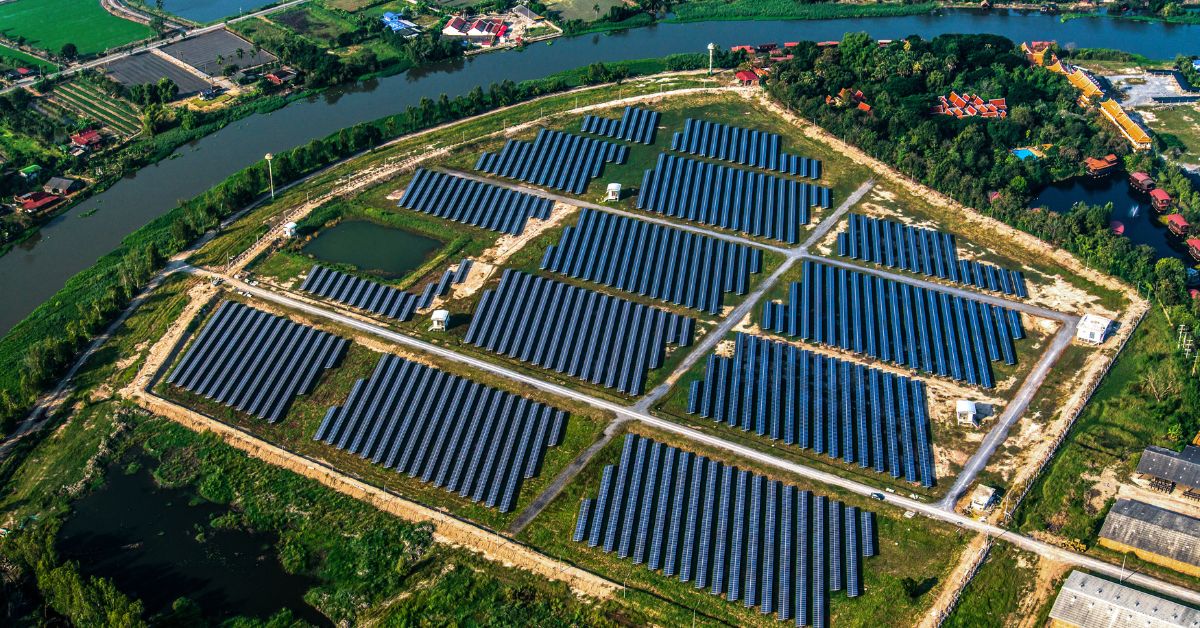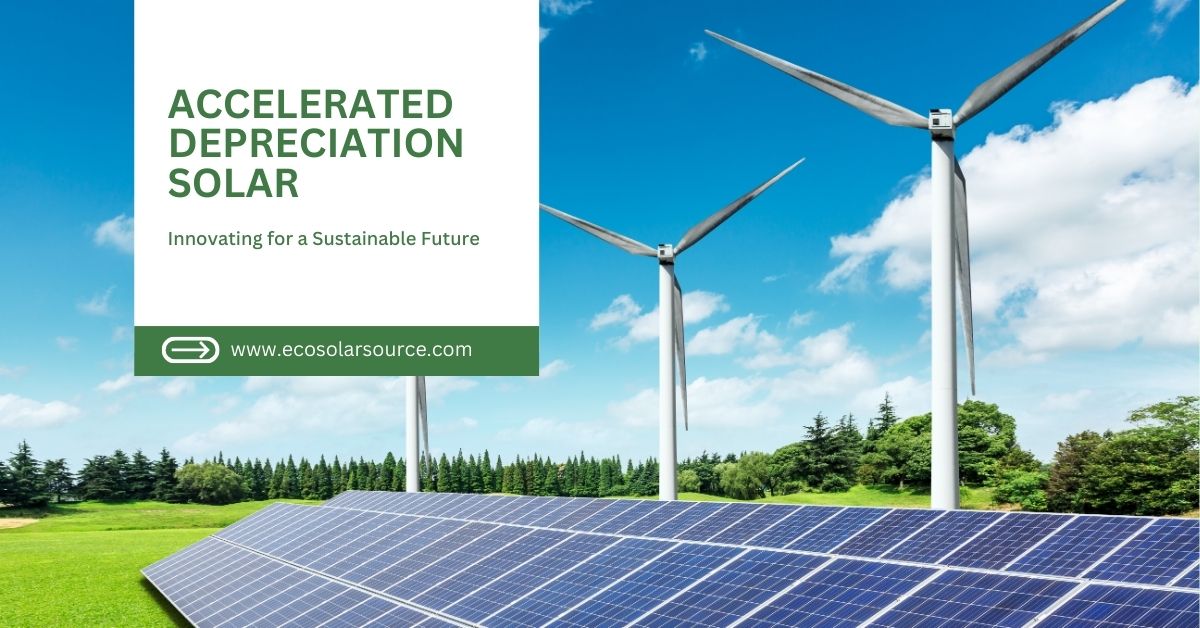Accelerated Depreciation Solar
Accelerated Depreciation solar energy systems is a financial incentive that allows businesses to recover their solar investment costs more quickly by expensing the asset over a shorter period, typically five years. This method reduces taxable income in the early years of the system’s operation, boosting cash flow and improving return on investment.
In many regions, this accelerated depreciation is paired with solar tax credits, further enhancing financial savings. By taking advantage of accelerated depreciation, companies can significantly lower the upfront cost of adopting solar energy, promoting sustainable practices while achieving long-term economic benefits and energy independence.
Accelerated Depreciation for Solar: Unlocking the Financial Benefits of Solar Investments
Table of Contents
- Introduction to Accelerated Depreciation for Solar
- Overview of Depreciation in Tax Accounting
- What Is Accelerated Depreciation?
- Why Accelerated Depreciation Matters for Solar Investors
- Understanding Depreciation in Solar Energy Investments
- Basics of Depreciation
- How Solar Assets Are Depreciated
- Economic Life of Solar Systems
- How Accelerated Depreciation Works for Solar
- Modified Accelerated Cost Recovery System (MACRS)
- Bonus Depreciation in Solar
- Differences Between Standard Depreciation and Accelerated Depreciation
- Eligibility for Accelerated Depreciation
- Who Can Use MACRS?
- Qualifying Solar Energy Projects
- Integration with Federal and State Incentives
- MACRS for Solar Energy Explained
- History of MACRS in Renewable Energy
- How to Calculate Depreciation with MACRS
- Case Study: Calculating Depreciation for a Commercial Solar Installation
- Bonus Depreciation: How It Enhances Solar Investments
- The Concept of Bonus Depreciation
- Eligibility for 100% Bonus Depreciation
- Phasing Out of Bonus Depreciation: What Investors Need to Know
- Financial Impact of Accelerated Depreciation on Solar Projects
- Immediate Tax Benefits
- Increasing ROI (Return on Investment)
- Long-Term Financial Considerations
- The Role of Accelerated Depreciation in Solar Financing
- Lowering Capital Costs
- Attracting Investors and Lenders
- Leveraging Depreciation to Improve Project Economics
- Tax Implications and Legal Considerations
- Tax Liability Reduction
- IRS Guidelines on Solar Depreciation
- Risks and Pitfalls to Avoid
- How Accelerated Depreciation Supports Sustainable Growth
- Encouraging More Solar Adoption
- Supporting Government Climate Goals
- Case Study: Growth of Solar Sector Due to Depreciation Incentives
- Common Misconceptions About Solar Depreciation
- Myth vs. Reality: How Depreciation Affects Solar Returns
- Addressing Concerns About Tax Avoidance
- FAQs about Accelerated Depreciation Solar
- Conclusion
- Summary of Key Benefits
- Future of Accelerated Depreciation in the Solar Sector
- Final Thoughts on Making the Most of Solar Depreciation
Accelerated Depreciation Solar
Introduction to Accelerated Depreciation for Solar
Overview of Depreciation in Tax Accounting
Depreciation is a key concept in tax accounting that allows businesses to deduct the cost of capital assets over time. It reflects the wear and tear, deterioration, or obsolescence of property or equipment used in operations. Depreciation reduces taxable income by allowing a portion of the asset’s cost to be deducted annually, spreading the financial burden of large investments.

What Is Accelerated Depreciation?
Accelerated depreciation is a method that allows greater deductions in the early years of an asset’s life. This is in contrast to standard depreciation methods, which spread deductions more evenly over the asset’s useful life. Accelerated depreciation provides an immediate financial benefit, as businesses can reduce taxable income more quickly. It is particularly relevant for capital-intensive industries like solar energy, where upfront investments are significant.
Why Accelerated Depreciation Matters for Solar Investors
Solar energy projects, particularly large-scale commercial installations, require substantial upfront investment. Accelerated depreciation methods like the Modified Accelerated Cost Recovery System (MACRS) and bonus depreciation allow investors to recoup a significant portion of their costs early in the life of the system. This boosts the project’s financial viability by improving cash flow and making solar investments more attractive.
Understanding Depreciation in Solar Energy Investments
Basics of Depreciation
Depreciation accounts for the reduction in the value of physical assets over time. For businesses, depreciation is a tax deduction that acknowledges this loss of value. With solar installations, depreciation applies to the equipment and infrastructure used to generate electricity.
How Solar Assets Are Depreciated
In the United States, solar assets are depreciated using MACRS, a method that accelerates the depreciation schedule for renewable energy investments. Under MACRS, solar equipment such as photovoltaic (PV) panels, inverters, and racking systems qualify for a five-year recovery period, even though these systems typically have a much longer operational life (25-30 years).
Economic Life of Solar Systems
While solar systems have a typical lifespan of 25-30 years, the accelerated depreciation schedule allows investors to claim the depreciation over a shorter period (five years in most cases). This rapid depreciation enables businesses to offset taxes earlier, improving the economics of solar investments.
How Accelerated Depreciation Works for Solar
Modified Accelerated Cost Recovery System (MACRS)
The MACRS system was introduced in the U.S. to stimulate investment in various industries by allowing businesses to depreciate assets over shorter periods. Solar energy projects qualify for MACRS under the five-year property class, meaning that the cost of a solar installation can be written off over five years. This greatly enhances the attractiveness of solar investments by providing earlier tax savings.
Bonus Depreciation in Solar
Bonus depreciation allows investors to deduct a significant percentage of the asset’s cost in the year it is placed in service. Currently, solar investments qualify for 100% bonus depreciation, meaning that businesses can deduct the entire cost of the solar installation in the first year. This is a powerful tool for businesses looking to reduce their taxable income immediately.
Differences Between Standard Depreciation and Accelerated Depreciation
Standard depreciation evenly spreads the asset’s cost over its useful life, while accelerated depreciation front-loads the deductions. For solar, accelerated depreciation methods like MACRS and bonus depreciation provide immediate tax benefits, improving the cash flow of solar projects and boosting their return on investment (ROI).
Eligibility for Accelerated Depreciation
Who Can Use MACRS?
Any business that invests in solar energy systems for commercial use is eligible to use MACRS to depreciate their solar assets. Additionally, businesses that lease solar energy systems may also benefit from MACRS if they own the system and meet IRS criteria.
Qualifying Solar Energy Projects
To qualify for MACRS, the solar project must meet the IRS guidelines for energy property. This typically includes solar PV systems installed for electricity generation, but can also extend to thermal energy systems used for heating or cooling. The solar property must be placed in service after a certain date to qualify for accelerated depreciation and bonus depreciation benefits.
Integration with Federal and State Incentives
Federal and state solar incentives such as the Investment Tax Credit (ITC) often work in tandem with MACRS depreciation. While the ITC provides a credit for a percentage of the total solar project cost, MACRS allows the remaining investment to be depreciated over time. These combined benefits can significantly reduce the overall cost of solar projects.
MACRS for Solar Energy Explained
History of MACRS in Renewable Energy
MACRS has been instrumental in encouraging investments in renewable energy projects since its introduction. Initially designed to boost economic growth, MACRS was extended to include solar energy as part of broader efforts to stimulate investment in clean energy technologies.

How to Calculate Depreciation with MACRS
Calculating depreciation under MACRS for solar systems involves determining the total cost basis of the system and applying a five-year recovery schedule. In the first year, a business can depreciate a significant portion of the asset’s cost using a specific depreciation percentage set by the IRS for each year of the asset’s life. The following years see diminishing depreciation percentages, front-loading the tax benefits.
Case Study: Calculating Depreciation for a Commercial Solar Installation
Consider a $500,000 solar installation for a commercial business. Under MACRS, the business could depreciate 20% of the system’s value in the first year and progressively smaller percentages over the next four years. Combined with the ITC and other incentives, this results in a significant reduction in tax liability.
Bonus Depreciation: How It Enhances Solar Investments
The Concept of Bonus Depreciation
Bonus depreciation provides businesses with the option to take an immediate deduction for a percentage of the solar investment. In recent years, 100% bonus depreciation has been available, meaning that businesses can deduct the full cost of the solar installation in the first year it is operational.
Eligibility for 100% Bonus Depreciation
To qualify for 100% bonus depreciation, the solar project must be placed in service within certain time frames set by the IRS. Solar energy property placed in service before a specific cut-off date (currently 2022 for 100% bonus depreciation) is eligible. After this date, the percentage of bonus depreciation will gradually phase down.
Phasing Out of Bonus Depreciation: What Investors Need to Know
Bonus depreciation is scheduled to phase out over the next few years. Starting in 2023, the bonus percentage will decrease incrementally. Investors in solar energy projects should plan accordingly to maximize their tax savings by taking advantage of the higher depreciation rates while they are still available.
Financial Impact of Accelerated Depreciation on Solar Projects
Immediate Tax Benefits
Accelerated depreciation significantly reduces taxable income in the early years of a solar project, improving short-term cash flow. The immediate tax benefits make solar energy projects more attractive to investors, reducing the payback period and increasing the project’s profitability.
Increasing ROI (Return on Investment)
The ability to depreciate a solar system over five years—combined with bonus depreciation—boosts the ROI for solar projects. Investors see a higher return due to the accelerated tax benefits, which offset the initial capital outlay and reduce the project’s financial risk.
Long-Term Financial Considerations
While accelerated depreciation offers short-term tax advantages, it also has long-term implications. Investors should carefully consider the impact on future tax liabilities and ensure that the depreciation strategy aligns with their overall financial goals.
The Role of Accelerated Depreciation in Solar Financing
Lowering Capital Costs
Accelerated depreciation lowers the effective cost of capital for solar projects by improving cash flow and reducing the tax burden in the early years of the investment. This makes it easier for businesses to finance solar installations, either through debt or equity financing.
Attracting Investors and Lenders
The tax advantages associated with accelerated depreciation make solar projects more attractive to investors and lenders, who see a faster return on their investments. This can help project developers secure more favorable financing terms, further reducing the cost of solar installations.
Leveraging Depreciation to Improve Project Economics
By leveraging accelerated depreciation, businesses can improve the overall economics of their solar projects, ensuring that they are financially viable. This is particularly important for large-scale commercial installations, where upfront costs can be prohibitive without tax benefits.
Tax Implications and Legal Considerations
Tax Liability Reduction
Accelerated depreciation reduces tax liability, providing businesses with immediate financial relief. However, investors need to understand the tax rules governing solar depreciation to avoid potential issues with the IRS.
IRS Guidelines on Solar Depreciation
The IRS provides specific guidelines on how solar energy property can be depreciated. It is crucial to follow these guidelines closely to ensure that the depreciation is applied correctly and that the business can fully benefit from the tax incentives.
Risks and Pitfalls to Avoid
One potential risk is the overestimation of tax benefits, leading to inaccurate financial projections. Investors should work closely with tax professionals to ensure that they fully understand the tax implications of accelerated depreciation and avoid common pitfalls.
How Accelerated Depreciation Supports Sustainable Growth
Encouraging More Solar Adoption
By reducing the tax burden on solar investments, accelerated depreciation encourages more businesses to adopt solar energy. This supports the growth of the renewable energy sector and helps meet global climate goals by increasing the share of clean energy in the energy mix.
Supporting Government Climate Goals
Accelerated depreciation is part of a broader policy framework designed to promote renewable energy and support government climate goals. By making solar investments more financially attractive, this tax incentive plays a key role in the transition to a low-carbon economy.
Case Study: Growth of Solar Sector Due to Depreciation Incentives
The rapid growth of the solar energy sector in recent years can be attributed in part to the availability of accelerated depreciation and bonus depreciation incentives. These tax benefits have lowered the cost of solar installations, making it easier for businesses to invest in clean energy.
Common Misconceptions About Solar Depreciation

Myth vs. Reality: How Depreciation Affects Solar Returns
There are common misconceptions about how depreciation impacts the financial returns of solar investments. Some believe that depreciation artificially inflates returns, but in reality, it is a legitimate and necessary financial tool that reflects the true economic value of solar systems over time.
Addressing Concerns About Tax Avoidance
Critics sometimes argue that accelerated depreciation is a form of tax avoidance, but it is a legal and encouraged practice designed to stimulate investment in key industries. Properly applied, accelerated depreciation incentivizes growth in renewable energy without undermining the overall tax base.
FAQs about Accelerated Depreciation Solar
- What is Accelerated Depreciation for Solar Energy Systems? Accelerated depreciation allows businesses to deduct a large portion of their solar energy investment from their taxes earlier than standard depreciation schedules.
- How does Accelerated Depreciation benefit solar energy investors? It provides immediate tax savings, allowing businesses to recover their investment in solar energy systems more quickly and improve cash flow.
- What is the Modified Accelerated Cost Recovery System (MACRS)? MACRS is a U.S. tax mechanism that allows businesses to depreciate assets like solar energy systems over five years, providing faster deductions compared to traditional depreciation schedules.
- Can I use both the Solar Investment Tax Credit (ITC) and Accelerated Depreciation? Yes, businesses can claim both the federal Solar ITC and MACRS, though the ITC reduces the depreciable basis by 50% of the ITC claimed.
- What is the depreciation schedule for solar energy systems under MACRS? Solar energy systems are depreciated over five years under MACRS, allowing for a significant portion of the system’s cost to be deducted during that period.
- Is Accelerated Depreciation available for residential solar installations? No, accelerated depreciation through MACRS is available only for businesses and commercial solar projects, not for residential systems.
- How much can businesses save by using Accelerated Depreciation for solar? Businesses can save approximately 20-30% of their solar energy system’s cost through accelerated depreciation, depending on their tax rate and other factors.
- What is the bonus depreciation for solar systems, and how does it work? Bonus depreciation allows businesses to deduct 80% of the cost of a solar system in the first year (as of 2023). This percentage is scheduled to phase down over time unless extended by new legislation.
- Do state tax laws affect Accelerated Depreciation for solar? Yes, state tax laws may have their own depreciation rules or incentives that differ from federal MACRS, so it’s important to check local regulations.
- Can non-profits and government entities use Accelerated Depreciation for solar? No, since these entities don’t pay taxes, they cannot benefit from tax deductions like accelerated depreciation. However, they can explore third-party financing options that may allow them to benefit indirectly.
Conclusion
Summary of Key Benefits
Accelerated depreciation provides significant financial benefits for businesses investing in solar energy. It reduces tax liability, improves cash flow, and shortens the payback period for solar installations. Combined with other incentives, solar energy projects are more financially viable and attractive to investors.
Future of Accelerated Depreciation in the Solar Sector
As the solar industry continues to grow, accelerated depreciation will remain a critical tool for attracting investment and supporting the expansion of clean energy infrastructure. Changes in federal tax policy, including the phasing out of bonus depreciation, will shape the future of this incentive, but its impact on the solar industry is likely to remain strong.
Final Thoughts on Making the Most of Solar Depreciation
For businesses looking to invest in solar energy, understanding the nuances of accelerated depreciation is essential for maximizing financial returns. By leveraging tax incentives like MACRS and bonus depreciation, businesses can reduce their tax liability, improve project economics, and contribute to a more sustainable future.
Click Here to Learn More About Accelerated Depreciation Solar
Click Here to Learn More About Accelerated Depreciation Benefit Solar India

